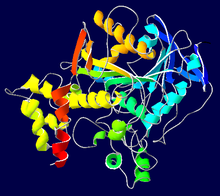| Revision as of 05:29, 17 January 2008 editBetacommand (talk | contribs)86,927 editsm Adding missing <references/> tag← Previous edit | Revision as of 16:04, 3 February 2008 edit undo58.177.113.21 (talk)No edit summaryNext edit → | ||
| Line 1: | Line 1: | ||
| ]]] | ]]] | ||
| ]]] | ]]] | ||
| An '''acetylcholinesterase inhibitor''' or '''anti-cholinesterase''' is a ] that inhibits the ] from breaking down ], so increasing both the level and duration of action of the ] acetylcholine. | An '''acetylcholinesterase inhibitor'''(]]:乙醯膽鹼酯酶抑製劑) or '''anti-cholinesterase''' is a ] that inhibits the ] from breaking down ], so increasing both the level and duration of action of the ] acetylcholine. | ||
| ==Uses== | ==Uses== | ||
Revision as of 16:04, 3 February 2008


An acetylcholinesterase inhibitor(]]:乙醯膽鹼酯酶抑製劑) or anti-cholinesterase is a chemical that inhibits the cholinesterase enzyme from breaking down acetylcholine, so increasing both the level and duration of action of the neurotransmitter acetylcholine.
Uses
Acetylcholinesterase inhibitors:
- occur naturally as venoms and poisons
- are used as weapons in the form of nerve agents
- are used medicinally:
- to treat myasthenia gravis. In myasthenia gravis, they are used to increase neuromuscular transmission.
- to treat Alzheimer's disease
- as an antidote to anticholinergic poisoning
Examples
reversible inhibitor
Compounds which function as reversible competitive or noncompetitive inhibitors of cholinesterase are those most likely to have therapeutic uses. These include:
- Organophosphates
- Carbamates
- Phenanthrine derivatives
- Piperidines
- donepezil, also known as E2020
- Tacrine, also known as tetrahydroaminoacridine (THA')
- Edrophonium
- Phenothiazines
Comparison table
| Inhibitor | Duration | Main site of action | Clinical use | Adverse effects |
|---|---|---|---|---|
| edrophonium | short | neuromuscular junction | diagnosis of myasthenia gravis | |
| neostigmine | medium | neuromuscular junction |
|
visceral |
| physiostigmine | medium | postganglionic parasympathetic | treat glaucoma (eye drops) | |
| pyridostigmine | medium | neuromuscular junction |
|
|
| dyflos | long | postganglionic parasympathetic | historically to treat glaucoma (eye drops) | toxic |
| ecothiopate | long | postganglionic parasympathetic | treat glaucoma (eye drops) | systemic effects |
| parathion | long | none | toxic |
quasi-irreversible inhibitor
Compounds which function as quasi-irreversible inhibitors of cholinesterase are those most likely to have use as chemical weapons or pesticides. These include:
Natural Compounds (Supplements)
Effects
Some major effects of anticholinesterases:
- Actions on the autonomic nervous system, that is parasympathetic nervous system will cause bradycardia, hypotension, hypersecretion, bronchoconstriction, GI tract hypermotility, and decrease intraocular pressure.
- SLUD syndrome.
- Actions on the neuromuscular junction will result in prolonged muscle contraction.
See also
References
- ^ Unless else specified n boxes, then ref is:Rang, H. P. (2003). Pharmacology. Edinburgh: Churchill Livingstone. ISBN 0-443-07145-4. Page 156
External links
- Acetylcholinesterase+inhibitors at the U.S. National Library of Medicine Medical Subject Headings (MeSH)
| Pharmacology: enzyme inhibition | |||||||||||
|---|---|---|---|---|---|---|---|---|---|---|---|
| Class | |||||||||||
| Substrate |
| ||||||||||
| Psychoanaleptics: Anti-dementia agents (ATC code N06D and others) | |
|---|---|
| AChE inhibitor medications | |
| Other medications | |
| Experimental BACE inhibitors | |